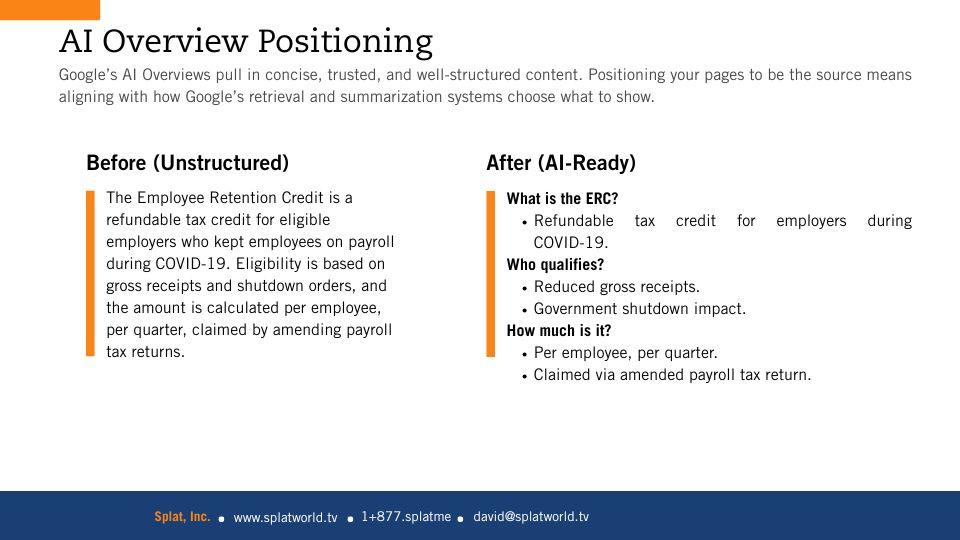How to breathe new life into old content in the era of AI answers and search
(Note: If you’re in a hurry you can scroll to the FAQ of this post.)
In the search world, new shorthand is multiplying fast: AI Optimization, GEO, AIO. The acronyms matter less than the reality — AI systems are already rewriting how content is discovered, summarized, and cited.
The truth is that most of us don’t have the bandwidth to reinvent our marketing strategy. We’re running overextended one-person marketing departments or working inside shrinking budgets. What we do have is existing content.
So the question becomes: how do you make existing content easier for large language models (LLMs) and AI-powered search to find, read, and cite?
This isn’t an exhaustive strategy — that’s impossible right now, because the rules are still shifting. Instead, this is a practical cheat sheet: quick fixes that give your content a better chance of surfacing inside AI-generated answers. (And if the definitions geek inside you is wondering: this is GEO-focused, not an exhaustive AIO strategy.)
I’ll split my suggestions into two groups: content fixes and technical fixes.
Content Fixes
1. Reorganize for answers
AI tools like Google’s Gemini or Microsoft Copilot work best when information is laid out clearly. Quotability is important. That means your content should be structured more like a Q&A than a long essay.
Instead of burying key details in long paragraphs, use headings that match the questions your audience is actually asking. Lead with the answer in one or two sentences, then expand. The clearer and more direct your copy, the more likely it is to be reused in an AI Overview.
For a tax law firm client of ours, we provided guidance on rewriting pandemic-era content about the Employee Retention Credit. The shift from dense paragraphs to structured Q&A made the copy far more usable for both readers and machines.

2. Use formats AI prefers
Certain content structures are consistently pulled into AI answers, including: FAQs, Comparison charts and tables, Step-by-step guides and Glossaries and definitions.
Original research, graphs, and data collection also carry extra weight. For instance, Bain’s research on zero-click behavior surfaced multiple times during preparation for a recent presentation. AI tools look for clear evidence and structured formats; they “grab on” to these kinds of assets.
3. Keep your language consistent
Large language models don’t “understand” the way humans do. They map patterns. If you describe the same product or service in ten different ways, you weaken the signal instead of reinforcing it. Use consistent terminology across your site. Favor plain phrasing. And when it makes sense, write quotable sentences that actually include your brand name, so attribution sticks when a platform cites your content.
4. Apply schema markup
This is an old SEO recommendation that’s newly relevant. Schema is the structured data that tells machines exactly what your content is about. Adding FAQ, Article, or Review schema makes your copy machine-readable — like translating your site into a language AI understands fluently.
Schema’s value has been debated in the past. But nearly every serious voice in the AI search space is pointing to its renewed importance as more platforms try to parse human-authored content. Implementation isn’t hard: you don’t need to hand-write JSON-LD. Free generators will produce the code for you to paste into your site.
Technical Fixes
1. Make sure AI crawlers can see your content
Some of today’s AI crawling limitations sound like SEO flashbacks. Years ago, Google couldn’t reliably read JavaScript. If your FAQs lived in an accordion tab, Google missed them.
That problem is back — at least for some AI tools. If your site relies heavily on JavaScript rendering, key content may be invisible to the crawlers feeding LLMs. Tools like AI Eyes give you a preview of what they actually see. If something critical is missing, adjust so it’s available in plain HTML. This may be a temporary issue, but for now it’s worth attention.
2. Validate your markup
Schema only works if it’s valid. Even small errors can make it unreadable. Run your markup through Google’s Rich Results Test or the Schema.org validator to confirm it’s error-free.
3. Strengthen trust signals
AI systems, like search engines, lean toward authority. Consistent business listings, positive reviews, and backlinks from reputable domains all improve the likelihood your site is cited in an AI answer. I hesitate mentioning this, because it goes beyond a quick content fix. However, it’s also a foundational layer you can’t ignore.
The Takeaway
AI search isn’t going away. But you don’t need to throw out everything you know. Start with what you have: reorganize it, mark it up, and make sure it’s visible to machines.
This is a cheat sheet, not a masterplan. But these steps increase the odds your existing content is included in the answers people already see.
Next time in The Click Brief: a deeper dive into the toolset for AIO/GEO — what’s useful, what’s hype, and where to focus.
And if you’d like help figuring out how these ideas apply to your specific site, let’s talk. You can grab 30 minutes with me here.
And, if you’re the TLDR kind of person, here’s an FAQ of this post, for reference:
FAQ: Preparing Existing Content for AI Search
1. How do I make my existing content AI-ready?
Start by reorganizing it so it reads like answers, not essays. Use clear headings that mirror real questions, lead with concise statements, and expand after. Apply schema markup (FAQ, Article, Review) so machines can parse your pages. Finally, check that the content is visible in HTML — not hidden in JavaScript tabs or accordions.
2. Can I repurpose old content to appear in AI results?
Yes. Most organizations already have material that can be reshaped for AI search. Think of FAQs, product explanations, or research reports you’ve created. By restructuring and marking them up, you give AI systems quotable blocks of text they can use in answers. It’s usually more efficient to repurpose than to start from scratch.
3. What types of content do AI tools prefer to cite?
Structured formats are most reliable: FAQs, comparison charts, step-by-step guides, and glossaries. AI also favors original research, graphs, and datasets. These are clean, scannable, and easy for models to lift into a synthesized answer.
4. Do I need to change my SEO strategy for AI optimization?
Not entirely — but you should extend it. Traditional SEO practices like authority building, schema, and strong on-page clarity still matter. What’s new is the emphasis on quotability and structured formats. SEO gets people to your page; AI optimization increases the odds your content gets used in the answer itself.
5. How can I tell if my content is showing up in AI answers?
Right now, measurement is limited. You can run your key queries in platforms like Google Search (AI Overviews), Perplexity, or Gemini and look for citations. Browser extensions like AI Eyes can also help preview how crawlers view your site. Expect better reporting tools to emerge, but for now, manual spot-checking is the best method.
6. Is schema markup really worth the effort for AI search?
Yes — with some nuance. Schema has been debated in SEO circles for years, but it’s becoming newly important as AI systems seek structured signals. Even if schema doesn’t guarantee inclusion, it reduces ambiguity and makes your content easier for machines to understand. Implementation is fast and low-cost, so the payoff-to-effort ratio is favorable.
7. What technical issues block AI crawlers from seeing my site?
The most common is hidden or JavaScript-rendered content. If your FAQs or key text only appear in dropdowns, tabs, or scripts, some crawlers won’t see it. Also, broken schema markup can prevent your structured data from being parsed. Running checks with tools like AI Eyes or Google’s Rich Results Test can reveal what’s hidden.



 Before the Tools, the Talent: What Job Listings Reveal About AI Adoption in Marketing (2025)
Before the Tools, the Talent: What Job Listings Reveal About AI Adoption in Marketing (2025)


